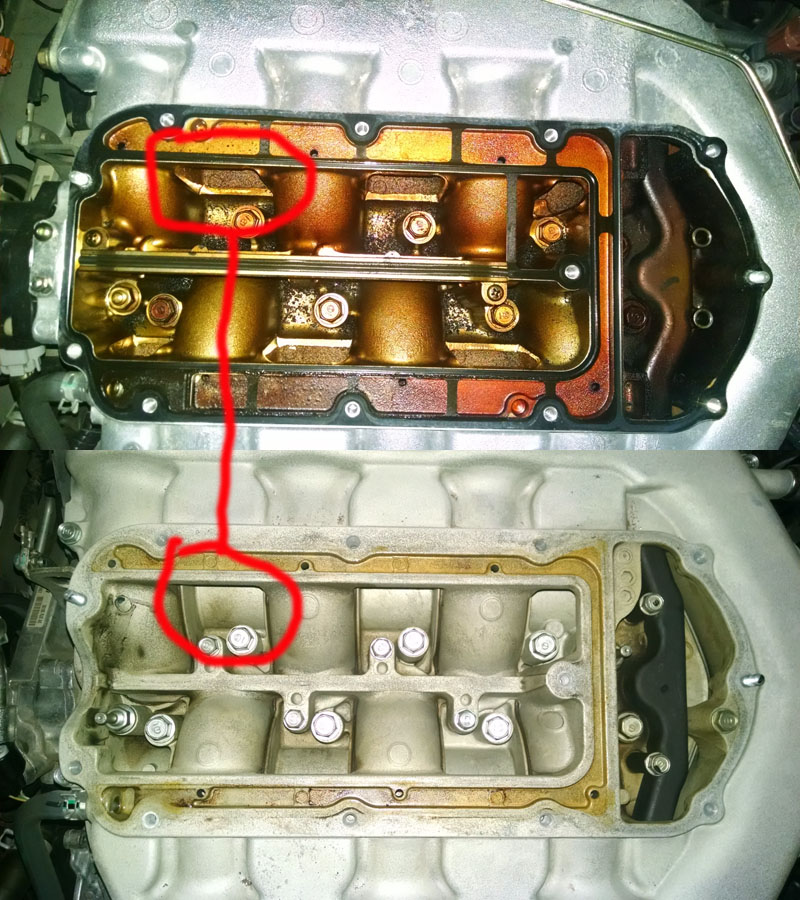After reading about various EGR-related issues with some of the Honda V-6s as they age, I took the top cover off the manifold of our 2005 MDX (128k miles). It was quite dirty inside, with lots of small carbon deposits. These appear to be the same as what's coming up out of the EGR pipe. The EGR pipe itself is free and clear, though it is lined with carbon -- like the chimney of an oft-used fireplace. The bits of carbon laying in the intake manifold are odd to me, though.
The flap running lengthwise across the middle of the intake manifold opens at about 3,600 rpm, and equalizes both halves of the manifold. It doesn't seem to me that it would be all that effective at creating more power, but it must work. It's hard to hear this transition in the MDX because of its quiet intake ducting, but you can certainly hear it in the Ridgeline -- the intake noise turns deeper and louder.
It appears to be very varnished, and I imagine that's coming from the PCV line. This engine has ALWAYS discolored fresh oil very quickly -- the oil is significantly darkened after only 1,000 miles or so. The PCV gasses enter the intake manifold via the silicone hose in the lower left of the photo and travel around the perimeter of the upper intake manifold through a channel that is sealed by the top cover with a thin paper gasket. There is a small hole in the top of each intake runner through which the PCV gasses are delivered.


The MDX's intake manifold is either dirtier than it should be, or the Ridgeline's intake manifold is cleaner than it should be. It has 99k miles. The MDX's intake manifold is a monobloc cast aluminum job while the Ridgeline uses a newer design split-case magnesium casting. It uses the same PCV design, with gasses traveling around the perimeter of the upper intake manifold; the Ridgeline's manifold cover uses a nicer pliable thick rubber seal instead of the MDX's flat gasket. But it's so clean in this one -- and indeed, the 8k mile oil that I drained out of it when I bought it looked as discolored (or even less so) as the 3k mile oil that's in our MDX right now. The current oil in the Ridgeline has about 2k miles on it, and it's still a golden tan color.


What do you think would cause these engines to run so differently, in terms of what's being deposited into the intake manifold? I have no issues with how the MDX's engine is running -- tailpipe emissions seem to be clean with no particulates, it returns fuel economy commensurate with the EPA estimates, etc. But I'd still like to clean it up some if I can. Since it was new, it's seen regular oil changes at
Strange. Any ideas?
The flap running lengthwise across the middle of the intake manifold opens at about 3,600 rpm, and equalizes both halves of the manifold. It doesn't seem to me that it would be all that effective at creating more power, but it must work. It's hard to hear this transition in the MDX because of its quiet intake ducting, but you can certainly hear it in the Ridgeline -- the intake noise turns deeper and louder.
It appears to be very varnished, and I imagine that's coming from the PCV line. This engine has ALWAYS discolored fresh oil very quickly -- the oil is significantly darkened after only 1,000 miles or so. The PCV gasses enter the intake manifold via the silicone hose in the lower left of the photo and travel around the perimeter of the upper intake manifold through a channel that is sealed by the top cover with a thin paper gasket. There is a small hole in the top of each intake runner through which the PCV gasses are delivered.


The MDX's intake manifold is either dirtier than it should be, or the Ridgeline's intake manifold is cleaner than it should be. It has 99k miles. The MDX's intake manifold is a monobloc cast aluminum job while the Ridgeline uses a newer design split-case magnesium casting. It uses the same PCV design, with gasses traveling around the perimeter of the upper intake manifold; the Ridgeline's manifold cover uses a nicer pliable thick rubber seal instead of the MDX's flat gasket. But it's so clean in this one -- and indeed, the 8k mile oil that I drained out of it when I bought it looked as discolored (or even less so) as the 3k mile oil that's in our MDX right now. The current oil in the Ridgeline has about 2k miles on it, and it's still a golden tan color.


What do you think would cause these engines to run so differently, in terms of what's being deposited into the intake manifold? I have no issues with how the MDX's engine is running -- tailpipe emissions seem to be clean with no particulates, it returns fuel economy commensurate with the EPA estimates, etc. But I'd still like to clean it up some if I can. Since it was new, it's seen regular oil changes at
Strange. Any ideas?


